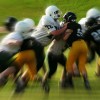Could Magnets Make Football Helmets Safer?
If you’ve followed the NFL in recent years, you’ve heard about the troubling issue of concussions affecting not only those currently playing, but players retired from the field. Repeat concussions and helmet-to-helmet hits cause significant brain damage later in life. How could magnets be used to improve the effectiveness of helmets in football?
In 2005, Dr. Bennet Omalu of the University of Pittsburgh along with his colleagues in the departments of epidemiology, pathology, human genetics and neurology, published a study that changed the way we view the often violent game. Not only would this study affect NFL players, but also those who suffer from multiple concussions, even long-time BMX great Dave Mirra. The study revealed severe brain damage and disease as a result of repeated mild traumatic brain injury such as getting hit in football. With this new knowledge of the risks that players and athletes take by participating in sports, doctors around the country are trying to develop a way to prevent and treat the disease.
One of the most noted football players of the last ten years suffering from concussions is wide receiver Wes Welker. Flash back a few years ago, Raymond Colello watched Wes when he received yet another brain damaging injury. Colello then took it upon himself to develop a device that may one day prevent helmet-to-helmet injuries from haunting athletes for the rest of their lives.
The device he set out to use wasn’t a fancy electronic device, but one that has been around for nearly 4,000 years, magnets. Understanding how magnets attract and repel each other, he thought he could use this to his advantage. To develop this potentially game-changing device, Colello started testing the repulsion effects of magnets in his garage to see if they would have a significant impact or not. He discovered that in a one-foot fall, the magnets reduced the force of the impact from 20 g’s to 0.2 g’s
“It was really quite shocking,” Colello told the Washington Post. “I couldn’t believe it the first time I saw it.”
After taking his discovery to the University of Virginia Commonwealth where he works, they filed a provisional patent and awarded him $50,000 for seed funding. Colello also started a Kickstarter campaign where anyone can contribute to his magnetic helmet device. When donating you can also receive rewards, like a “I Helped Save Brains...the Magnet Project” hat. The campaign runs through June 24th, and has a goal of $10,000. Colello is also a finalist for a $400,000 grant from the National Institute of Health.
We use magnets in many aspects of our lives sometimes without even knowing it, but will Colello’s magnetic helmets become the standard in American football?

